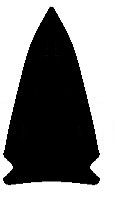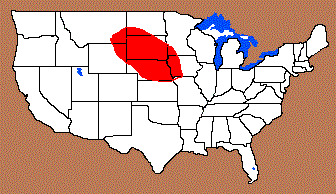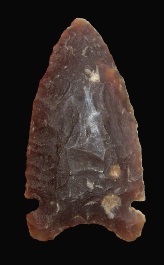Outline is Representative of Size and Shape:

Name Details:
Identified By: George Agogino and W.D. Frankforter
Named For: Type Site
Date Identified: 1960
Type Site: Simonsen Site, along the Little Sioux River, northeastern Iowa
Identified By: George Agogino and W.D. Frankforter
Named For: Type Site
Date Identified: 1960
Type Site: Simonsen Site, along the Little Sioux River, northeastern Iowa
Point Validity:
Valid type
Agogino was an anthropologist and was the founder and professor of the Department of Anthropology at the University of New Mexico. He was an expert on the Great Plains Paleo Indians. Frankforter was a geologist with the Cherokee Museum in Iowa. He specialized in geo-archeological studies of the Missouri River Basin and the surrounding region. This type was named in a professional publication and has many professional references. This is considered a valid type.
Agogino was an anthropologist and was the founder and professor of the Department of Anthropology at the University of New Mexico. He was an expert on the Great Plains Paleo Indians. Frankforter was a geologist with the Cherokee Museum in Iowa. He specialized in geo-archeological studies of the Missouri River Basin and the surrounding region. This type was named in a professional publication and has many professional references. This is considered a valid type.
Simonsen Side Notch
AKA: Long CreekCluster: Large Side Notch Cluster
Description of Physical Characteristics and Flaking Pattern:
This is a medium triangular side notched point with an elliptical cross section. The blade is broad and is most commonly straight, but may vary to slightly excurvate. Parallel U shaped notches are lower on the blade and commonly as wide as they are deep. The widest portion of the point is at the shoulders and base. The stem is expanding. The base may vary from straight to slightly concave. The base is primarily concave but may range to almost straight with basal corners typically square and tapered down towards the base. The base is thinned using long pressure flaking, but may be finished with shorter pressure flakes removed and basal grinding being commonly present. This point is manufactured using random percussion flaking and finished with pressure flaking forming a random flaking pattern.
Size Measurements:
Total Length - 20 to 50 mm, Blade Width - 19 to 32 mm
Total Length - 20 to 50 mm, Blade Width - 19 to 32 mm
Commonly Utilized Material:
Various local materials and cherts commonly using heat treatment
Various local materials and cherts commonly using heat treatment
Additional Comments:
There are many similar types with many of them considered the same type or at least a continuum of the same type. The Turin point is often combined with this type in literature, but differs in that the notch enters from the corners rather than the side. Morrow (1984) points out that this is the same point as the Little Sioux point from Iowa. Others note that this is the same point as the Long Creek point from Saskatchewan. It should be noted that many consider the Long Creek point the same as the Oxbow point. When comparing the accepted dates for these type, it may be that the Turin point (Early Archaic) was followed by the Simonsen / Little Sioux (Early to Middle Archaic), which led into the Long Creek / Oxbow (Middle Archaic).Morrow (2006) notes that Avonlea points are similar in outline, but are much smaller and thinner representing true arrow points.
These points may are similar to the Rustad Quarry points of North Dakota, except the Rustad Quarry points are smaller. The two points may be the same point with the Rustad Quarry point being smaller because of the local material used (W11).
There are many similar types with many of them considered the same type or at least a continuum of the same type. The Turin point is often combined with this type in literature, but differs in that the notch enters from the corners rather than the side. Morrow (1984) points out that this is the same point as the Little Sioux point from Iowa. Others note that this is the same point as the Long Creek point from Saskatchewan. It should be noted that many consider the Long Creek point the same as the Oxbow point. When comparing the accepted dates for these type, it may be that the Turin point (Early Archaic) was followed by the Simonsen / Little Sioux (Early to Middle Archaic), which led into the Long Creek / Oxbow (Middle Archaic).Morrow (2006) notes that Avonlea points are similar in outline, but are much smaller and thinner representing true arrow points.
These points may are similar to the Rustad Quarry points of North Dakota, except the Rustad Quarry points are smaller. The two points may be the same point with the Rustad Quarry point being smaller because of the local material used (W11).
Distribution:
Distribution Comments:
These points are most commonly found in Nebraska and Iowa. May be found in other highlighted areas with less frequency.
These points are most commonly found in Nebraska and Iowa. May be found in other highlighted areas with less frequency.
Age / Periods:
Date: 8,000 - 6,000 B.P. (Horizon II)
Cultural Period: Early to Middle Archaic
Glacial Period: Middle Holocene
Culture:
Date: 8,000 - 6,000 B.P. (Horizon II)
Cultural Period: Early to Middle Archaic
Glacial Period: Middle Holocene
Culture:
Age Details:
It is felt that these represent the earliest notched points to occur on the Northern Plains. They are associated with bison kills at the Simonsen Site, Cherokee Sewer Sites, the Itasca Site, and the Granite Falls Site (Morrow, 2016).
It is felt that these represent the earliest notched points to occur on the Northern Plains. They are associated with bison kills at the Simonsen Site, Cherokee Sewer Sites, the Itasca Site, and the Granite Falls Site (Morrow, 2016).
Similar Points:
Avonlea, Hickory Ridge, Howard County, Little Sioux, Long Creek, Oxbow, Samantha, Turin, Tama, Yonkee
Avonlea, Hickory Ridge, Howard County, Little Sioux, Long Creek, Oxbow, Samantha, Turin, Tama, Yonkee
Other points in this cluster / Related / Associated Points:
Big Sandy ,Cache River Godar, Graham Cave, Greenbrier, Hemphill, Howard County, Madison Side Notched, Osceola, Osceola Greenbrier, Raddatz
Big Sandy ,Cache River Godar, Graham Cave, Greenbrier, Hemphill, Howard County, Madison Side Notched, Osceola, Osceola Greenbrier, Raddatz


